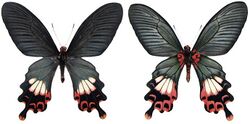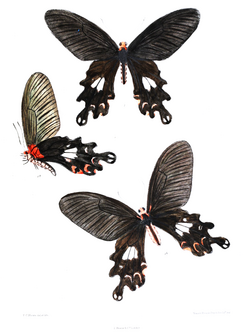Biology:Papilio bootes
| Tailed redbreast | |
|---|---|

| |
| Scientific classification | |
| Domain: | Eukaryota |
| Kingdom: | Animalia |
| Phylum: | Arthropoda |
| Class: | Insecta |
| Order: | Lepidoptera |
| Family: | Papilionidae |
| Genus: | Papilio |
| Species: | P. bootes
|
| Binomial name | |
| Papilio bootes Westwood, 1842
| |
Papilio bootes, the tailed redbreast, is a swallowtail butterfly found in Asia. Within their wide distribution about four population variants have been named as subspecies. They have been placed within the Menelaides clade by a 2015 phylogenetics study.[1]
Description
Male upperside velvety black. Forewing with pale internervular streaks that do not reach the terminal margin and only obscurely extend into the cell. Hindwing with similar streaks in interspaces 5 and 6, but the ground colour of the cell and of the lower and posterior portions of the wing uniform; interspaces 3 and 4 with elongate somewhat oval white spots at base, an admarginal red spot at tornus and at apex of interspace 2, and similar white spots intermixed with a few reddish scales as follows: one at apex of interspace 3, two near apex of tail, one on each side of vein 4, and a fourth at apex of interspace 4; the cilia black, touched with white in the middle of the interspaces; over the red tornal spot is a minute red crescent mark. Underside similar; the pale adnervular streaks on the forewing are more prominent and extend well into the cell; two or three red spots at extreme base of costa. Hindwing: ground colour as on the upperside, but in interspaces 6 and 7 silky black with a slight greenish lustre: markings as on the upperside, but the base of the wing dark red crossed by the black veins, the tornal red spot with a much broader lunular mark above it, and similar lunules above the admarginal spots in interspaces 2 and 3, that in 3 sometimes confluent with the admarginal spot. Antennae, thorax posteriorly and abdomen black; head and thorax in front red; beneath: the palpi, thorax and abdomen red, the latter two with black markings.
Female. Similar. Upperside: ground colour brownish black; forewing with the internervular pale streaks broader and more prominent, a small spot of red at base of wing; hindwing with an additional oval while spot in the interspace below the white spots in interspaces 3 and 4, and postdiscal lunular markings in interspaces 1 to 4. Of these the lunules in 1 and 2 are red, in 3 white irrorated with a few red scales, and in 4 pure white. Underside similar to that in the male, the red at base of wings more extended, the white discal spot in interspace 2 very small, irrorated with red scales; the postdiscal, lunular and admarginal spots larger, with a white postdiscal lunule in interspace 4. Antennae, head, thorax and abdomen similar to those of the male but the red of a paler tint.[2]
Subspecies
- Papilio bootes mindoni (north-eastern Burma)
- Papilio bootes janaka (northern Burma)
- Papilio bootes xamnuensis (north-eastern Laos)
- Papilio bootes ssp. (northern Vietnam)
Status
This butterfly is not common but is not regarded as threatened. It is protected by law in India.[3]
See also
- Papilionidae
- List of butterflies of India
- List of butterflies of India (Papilionidae)
References
- ↑ Wu, Li-Wei; Yen, Shen-Horn; Lees, David C.; Lu, Chih-Chien; Yang, Ping-Shih; Hsu, Yu-Feng (2015-10-20). Boykin, Laura M.. ed. "Phylogeny and Historical Biogeography of Asian Pterourus Butterflies (Lepidoptera: Papilionidae): A Case of Intercontinental Dispersal from North America to East Asia" (in en). PLOS ONE 10 (10): e0140933. doi:10.1371/journal.pone.0140933. ISSN 1932-6203. PMID 26484776.
- ↑ Bingham, C.T. (1905). The Fauna of British India, Including Ceylon and Burma Butterflies. 1 (1st ed.). London: Taylor and Francis, Ltd..
- ↑ Collins, N. Mark; Morris, Michael G. (1985). Threatened Swallowtail Butterflies of the World: The IUCN Red Data Book. Gland & Cambridge: IUCN. ISBN 978-2-88032-603-6. https://www.biodiversitylibrary.org/item/98674#page/7/mode/1up.
Wikidata ☰ Q9199417 entry
 |



